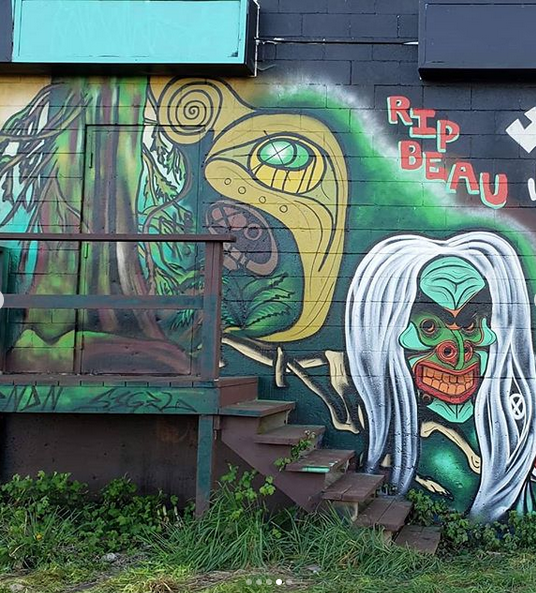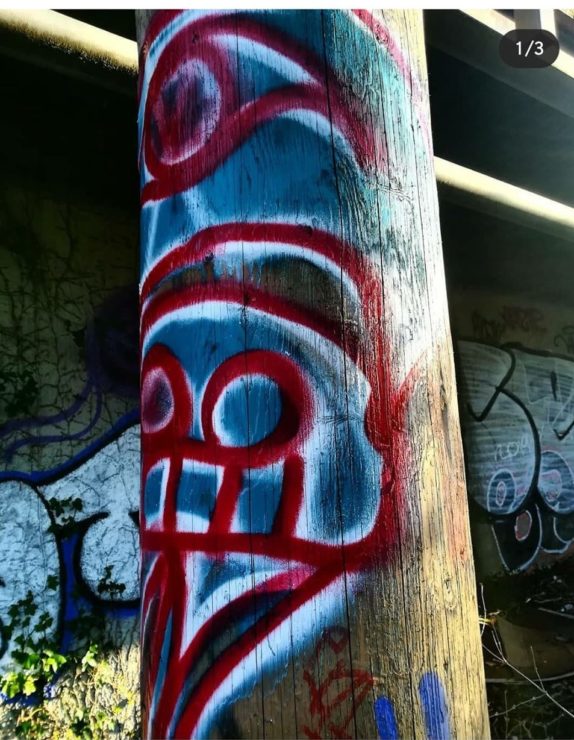Kwakwakaʼwakw and Nuu–chah–nulth graffiti artist brings Indigenous art to streets of Victoria

One summer afternoon in Victoria, B.C, a graffiti artist in a wild mood takes advantage of the low tide to access the wall down by the Johnson Street bridge and catch some daytime sprays. Bandana over his face, he works on a filled-in piece. Suddenly, while painting, he hears a loud “hey!” coming from behind him. The Kwakwakaʼwakw and Nuu–chah–nulth artist stops spraying. Just as he’s about to make a run for it, he notices the man is Indigenous. He pauses. The worker asks, “how’s it going?”
“Oh, doing good, just doing some Native art down here” the artist responds. The man points further down the wall at a bear design of his. “Did you do that one over there? I saw it a couple weeks ago. This whole wall should be done with Native art,” he says. Relieved that the onlooker turned out to be a fan, the artist returns to his cans of paint and continues to work on another in-your-face reminder of the unceded territories that Victoria locals are living on.
Since 2017, the artist’s hawks, bears, and various other designs have been popping up all around the city of Victoria, as well as his more traditional graffiti-style tag, PNDN — pronounced “Pindian.” The dozens of pins that adorn his jacket speak for themselves, explaining the word he chose as his tag — many have Indigenous art on them, others are from various punk bands, or carry slogans such as “No Pipelines.”
What makes PNDN’s work so unique, is that it’s graffiti in its purest form — street bombing.
As he describes it, he’s “decolonizing the streets, one tag at a time.” Rather than doing a mural, which requires applications and city approval, all PNDN needs is a paint pen, mop, or spray can in order to redecorate the streets.
Besides some time spent in Vancouver, PNDN has lived in Victoria all his life. Now 28 years old, he spent a lot of his childhood in the Blanshard Courts, near what is now called Quadra Village. He has been drawn to graffiti for a long time.
“When I first started drinking and smoking weed and stuff, when I was 11 years old, seeing a lot of tags around, I started developing my own signature — which I still use as my signature…I have a vague memory of writing on something, but I remember my mom telling me I can’t be doing that.”
In 2014, PNDN discovered the work of Corey Bulpitt, a traditional Haida artist based in Vancouver who uses spray-paint as a medium for art and commissioned murals.
“Seeing his art, and seeing someone be able to do traditional stuff with spray-paint, I dunno” he pauses. “In all my years of getting in trouble, drinking, and going to punk shows, I never thought of trying to do anything with spray-paint. But that made me really want to figure it out.”
PNDN is by no means the first Indigenous graffiti artist — many people like Corey Bulpitt do murals, legal walls, and larger pieces.
“Something that I’d say about writing on walls, is that our people have done it for hundreds and hundreds of years […] We’d paint on mountains with our hands,” PNDN says. “Separating Native people from nature, that’s the true fucking vandalism to me.”

After catching the attention of Victoria’s art community with his tags, PNDN was invited in November of 2019 to paint at the Waste Land Climate Anxiety House exhibition, a public art project that focused on climate change and took place in a house slated for demolition.
Since then, he has worked with other artists on large pieces at the Esquimalt Trackside Gallery, and Wildfire Cafe.
“It’s my own way of Indigenizing the streets, tagging modern day street totem poles. It’s my way of decolonizing the place and connecting to the land beneath the concrete and acknowledging the ancestors of this territory,” says PNDN.
Not only does his art make you stop and think about the land that we live on, it also raises the question about who really vandalized this land. Is his spray-paint vandalism? Or is the true vandalism the objects that his art decorates and reclaims? The buildings, asphalt streets, and concrete sidewalks desecrate the land where forests once stood, in a way that a little bit of paint could never.

Through graffiti, PNDN has accomplished something in Victoria that the local government either cannot do, or isn’t willing to do. For a city that likes to be seen as progressive, there is an alarming lack of public Indigenous art, according to PNDN. He emphasizes that Victoria is far behind cities like Vancouver, where Indigenous art is much more abundant.
“Compared to a place like Vancouver, there’s murals everywhere, now. Native artists doing murals, public art, stuff with the city. I love it…when you compare it to here, it’s a very colonial city, it’s the place where Hudson’s Bay sent off their smallpox blankets, it’s the place of the parliament building, it’s an old white city,” he says.
This lack of Indigenous art was a big part of why PNDN started writing graffiti.
“That’s a big reason why I wanted to start doing Native art around, cause I just don’t see enough of it,” he says. “I especially don’t see enough of it on the streets, and there’s a Native population around here that needs to be seeing more of that. And there’s a lot of non-Native people that need to be seeing more of that.”






